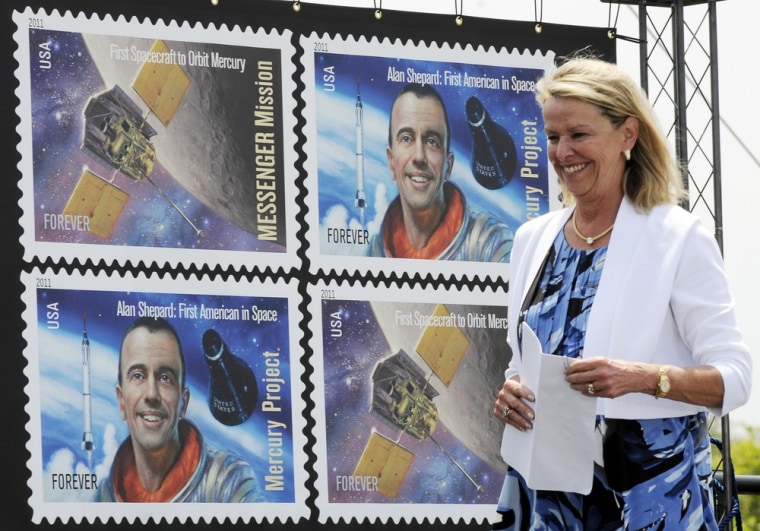The first American in space, Mercury astronaut Alan Shepard, was honored with his own stamp Wednesday on the eve of the 50th anniversary of his flight.
The Postal Service dedicated the Forever stamp Wednesday to commemorate Shepard's suborbital flight on May 5, 1961. He is the first astronaut to be honored, all by himself, on a stamp.
Twenty Shepard family members, including the late astronaut's three daughters, gathered at Kennedy Space Center with more than 100 others for the afternoon ceremony, held in an outdoor rocket garden. A replica of the black and white Mercury Redstone rocket that propelled Shepard on his 15-minute journey rose behind the stage.
One of the two surviving Mercury seven astronauts — Scott Carpenter — drew applause when he said he was pleased that a Forever stamp was chosen to honor Shepard. Forever stamps don't have a value on them and remain valid for first-class postage regardless of rate increases.
"That's appropriate to the stamp, but it is also appropriate to the time we should honor and remember Alan B. Shepard and Freedom 7," said Carpenter, wearing a navy ball cap adorned with the Mercury 7 emblem.
Carpenter laughed as he recalled that Shepard didn't like it that Soviet cosmonaut Yuri Gagarin beat him into space by less than a month. But he said the success of Shepard's flight helped lead America to the moon.
From Mercury to the moon
Shepard's Freedom 7 capsule soared 116 miles (185 kilometers) high and 302 miles (483 kilometers) to the east of Cape Canaveral. It reached a speed of 5,100 mph (8,160 kilometers per hour) before splashing down into the Atlantic.
Barely three weeks later, President John F. Kennedy committed the nation to landing a man on the moon by decade's end and bringing him back safely.
Shepard went on to command Apollo 14 in 1971 and became the fifth man to walk on the moon. He died in 1998 at age 74.
On Wednesday, Carpenter made note of "the first steps from the home planet that were taken by the family of man." Indeed, Shepard himself called his Mercury flight "just the first baby step, aiming for bigger and better things."
Daughter Julie Shepard Jenkins recalled how her father met with Kennedy at the White House a few days after the flight. While the two were talking, Caroline Kennedy skipped in.
"So John F. Kennedy introduced Caroline to the first American into space," Jenkins said. "She looked at Daddy and then she looked at her father with a very quizzical look. And she says, 'Where's the chimpanzee?' "
Ham the chimpanzee rode a Mercury Redstone rocket into space on Jan. 31, 1961. The Mercury astronauts long contended America could been in space first if there hadn't been so many test flights.
"Daddy never thought of himself as a hero. He was just doing his job," Jenkins said. "And one last thing, please take advantage of your new ability to send our father into space again. Put a stamp on a letter."
More stamps to come
NASA Administrator Charles Bolden Jr., a former shuttle astronaut, said Shepard set an example for all those who followed him into space. All told, 335 Americans have rocketed toward space. There have been 164 U.S. manned space missions to date, all from Cape Canaveral.
"I look forward to giving the Postal Service plenty more ideas for stamps to honor the space program," Bolden said.
Shepard family members, astronauts, NASA officials and hundreds of others will gather again Thursday morning at the actual site from which Shepard blasted off, to mark the exact moment of liftoff: 9:34 a.m.
And on Saturday morning, a dozen or so former astronauts will take part in a parade in Cocoa Beach, riding in Corvettes just as the Mercury astronauts did so long ago.
John Glenn, the first American to orbit the Earth on Feb. 20, 1962, had to bow out of the anniversary festivities because of a death in the family.
On Wednesday, the Postal Service also issued a Forever stamp to honor NASA's Messenger spacecraft, the first to orbit the planet Mercury. It was launched from Cape Canaveral in 2004 and entered orbit around Mercury last month.
